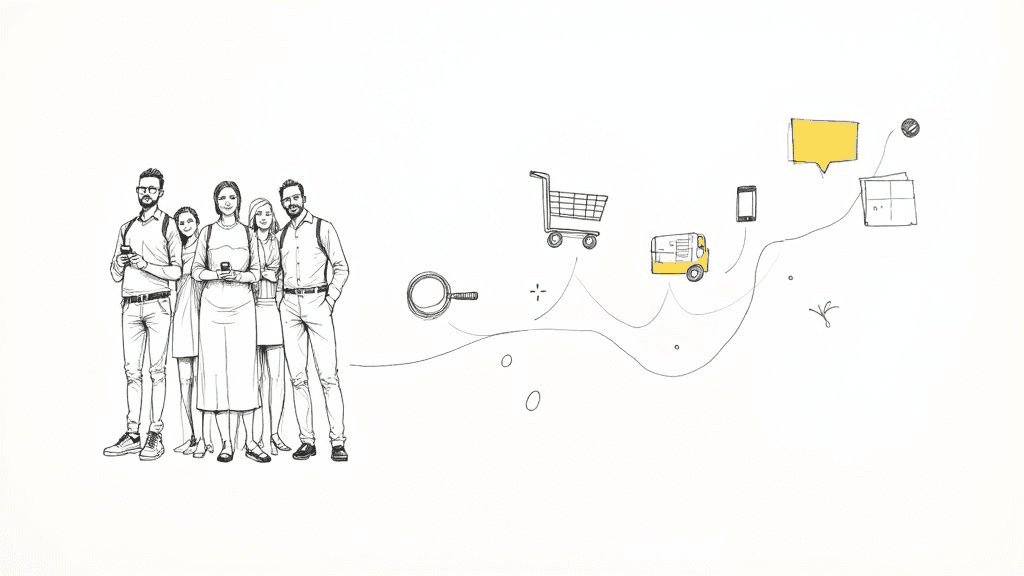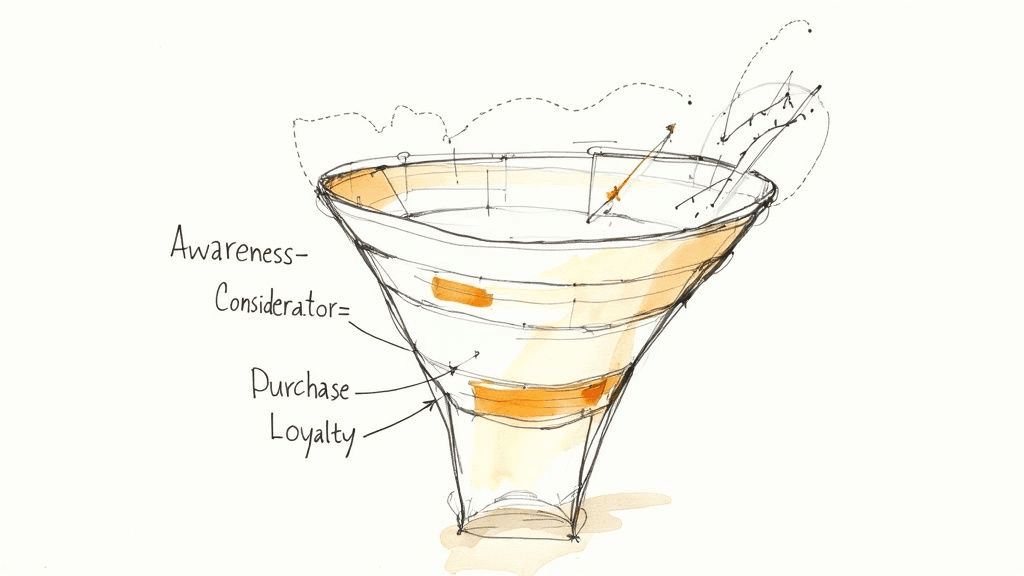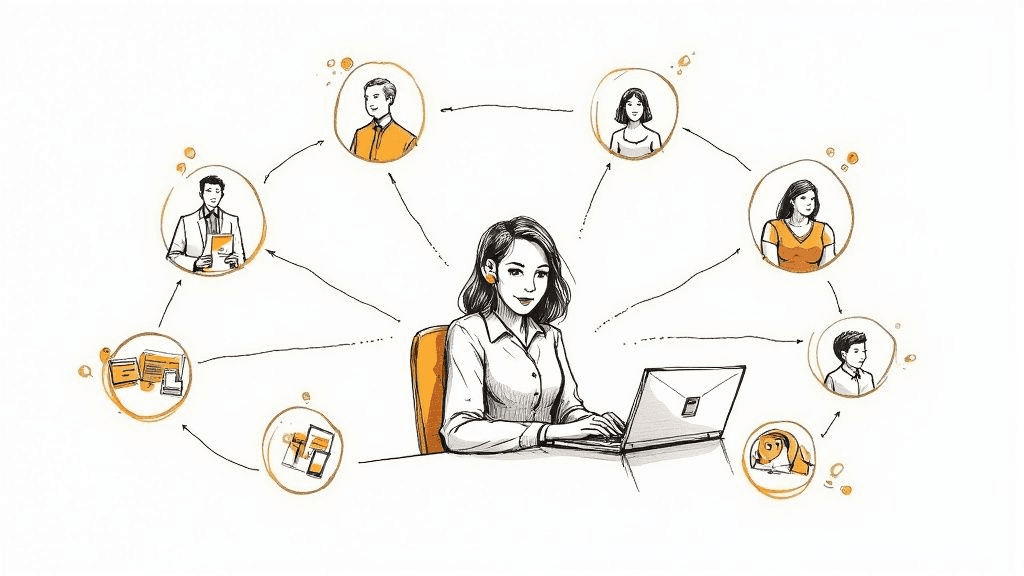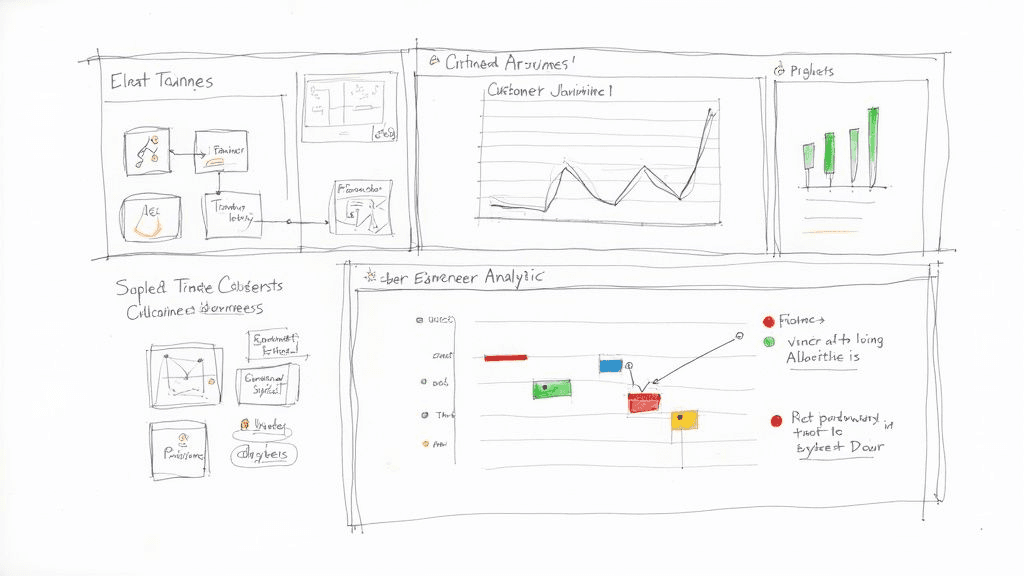Customer Journey Optimization: The Ultimate Guide to Transforming Customer Experience
Master customer journey optimization with battle-tested strategies that drive measurable business growth. Learn practical frameworks for enhancing every touchpoint from industry experts who've revolutionized customer experiences.
Understanding the Game-Changing Impact of Journey Optimization

Making your customers' journey smooth and enjoyable has become essential for business success. Customer journey optimization helps companies grow steadily and build lasting relationships with customers. Let's explore why getting this right matters so much and how it directly impacts business results.
The Competitive Advantage of Optimized Journeys
Picture your customer's experience like planning a trip. An optimized journey feels like traveling on a well-maintained road with clear signs and enjoyable stops along the way. When customers encounter a smooth, thoughtful experience, they're more likely to return and recommend it to others.
Take two similar software companies as an example. The first focuses only on features, while the second carefully maps and improves every customer interaction from first contact through ongoing support. The second company typically sees better results - more sales, longer customer relationships, and stronger word-of-mouth recommendations. This happens because customers naturally gravitate toward experiences that feel easy and valuable.
The numbers back this up convincingly. Research shows that companies excelling at customer experience outperform competitors by 80%. Even more striking, 84% of businesses see their revenue grow after improving customer experiences. For more insights, check out these customer journey optimization statistics.
Beyond Satisfaction: Driving Business Outcomes
While keeping customers happy matters, customer journey optimization aims for concrete business results. This means going beyond basic satisfaction to create experiences that measurably improve key metrics like sales, retention, and referrals.
By studying how customers interact with your business, you can spot opportunities you might have missed. Using data to understand customer behavior helps companies make smart choices about where to focus their efforts. For practical guidance on this approach, see this guide on creating customer-focused marketing strategies.
From Reactive to Proactive: Anticipating Customer Needs
Smart businesses don't wait for problems to fix them - they prevent issues before they happen. This means carefully analyzing customer data and feedback to understand what people want and need. Companies can then create personalized experiences that feel natural and helpful, building the kind of relationships that keep customers coming back year after year.
Mastering the Art of Journey Mapping and Analysis

A well-crafted customer journey map shows exactly how customers interact with your business from start to finish. By mapping these interactions carefully, companies can spot opportunities to improve experiences and build stronger customer relationships. The insights from journey mapping help businesses make smart decisions about where to focus their efforts.
Uncovering the Customer Lifecycle Through Mapping
A complete journey map traces every step from when customers first learn about your brand through becoming loyal advocates. This process identifies all the key touchpoints where customers interact with your business - like browsing your website, reading blog posts, talking to support, or making purchases. For example, when mapping a software company's customer journey, you might track how someone discovers the product through content, tries a free version, becomes a paying customer, and eventually renews their subscription.
Identifying and Addressing Pain Points with Gap Analysis
A thorough gap analysis helps find the differences between how customers currently experience your brand versus how you want them to experience it. This reveals problem areas like confusing checkout flows, slow page loads, or unhelpful support interactions that need fixing. For instance, if customers frequently abandon their shopping carts, gap analysis can uncover exactly where and why they get stuck in the process. Finding and fixing these friction points leads to happier customers and better business results.
Data-Driven Journey Maps: Combining Qualitative and Quantitative Insights
The most useful journey maps blend hard data with customer feedback. Numbers from analytics show what customers do, while surveys and interviews reveal why they do it. Say analytics indicate many people leave a product page - customer feedback might explain it's because the pricing isn't clear or the product description is confusing. Having both types of information creates a complete picture of customer behavior and points to specific improvements.
Prioritizing Improvements and Measuring Emotional Impact
Once you've mapped the journey and found gaps, focus first on fixing the issues that will help customers most. Track both behavior changes and emotional responses to your improvements. Simple metrics like customer satisfaction scores show if changes actually make experiences better. Keep testing and refining based on real customer data and feedback. Small, targeted improvements often have the biggest impact on customer happiness and business growth.
Transforming Digital Touchpoints Into Conversion Engines

A great customer experience requires careful attention to every interaction between your brand and potential customers. From the first advertisement to post-purchase support, each touchpoint presents an opportunity to guide prospects toward becoming loyal customers.
The Psychology of Digital Interactions
People's online behaviors directly impact the success of your customer journey optimization efforts. For instance, website speed plays a crucial role - if pages load slowly, visitors get frustrated and leave before completing purchases. Clear navigation and prominent calls-to-action make it easy for users to take desired actions. The simpler you make decision-making, the more likely visitors are to convert.
Personalization: More Than Just a Name
Real personalization focuses on understanding and meeting individual customer needs. This means showing product recommendations based on browsing history and creating targeted email campaigns for different customer groups. When you deliver experiences that feel truly personal, customers form stronger connections with your brand.
Removing Friction at Critical Conversion Points
Finding and fixing obstacles in the customer journey can dramatically improve results. Common friction points include complex checkout flows, unclear policies, and hard-to-find contact information. De Beers provides an excellent example - after analyzing their customer journey data, they discovered engagement ring browsers were likely to book store visits. By adding personalized appointment booking pop-ups on bridal product pages, they achieved a +27% increase in appointment requests. Read more details in the De Beers' case study.
Using Technology and Behavioral Data
Modern tools help businesses understand and improve the customer journey. A/B testing lets you experiment with different website elements to see what resonates with visitors. Analyzing user behavior data reveals patterns and preferences you can use to refine the experience. This data-driven approach helps companies make smart decisions that increase conversions. For additional insights, check out this guide on mastering omnichannel ecommerce marketing automation.
Creating conversion-focused digital touchpoints requires deep customer understanding, smart personalization, smooth experiences, and data-backed decisions. When done right, this comprehensive approach delivers measurable improvements in conversion rates and customer loyalty while strengthening your bottom line.
Building Data-Driven Optimization Engines

Improving the customer journey starts with understanding how to use data effectively. The key is converting raw customer information into clear action steps that enhance experiences and grow your business. Let's explore how to build systems that enable ongoing optimization based on real customer data.
Frameworks for Data Collection and Analysis
Getting started requires gathering the right mix of customer data. Companies need to pull information from multiple sources like Google Analytics, CRM systems, and customer surveys. For example, analytics show how people use your website, while CRM data reveals details about individual customers. Combining these creates a complete view of behavior patterns.
Don't forget about gathering qualitative feedback too. Customer surveys, interviews, and social media comments provide crucial context about what people think and feel. This adds an important human element to the numbers, helping explain the motivations driving customer actions.
Predictive Modeling and Anticipating Customer Needs
Once you have quality data, you can build predictive models to spot patterns and forecast future behaviors. These models examine past actions to identify which customers might stop buying or who's most likely to respond to certain offers. This allows for proactive outreach before issues arise.
The results speak for themselves - one US ecommerce company saw a 5% increase in customer retention after implementing data-driven optimization. They also streamlined their sales process by analyzing customer behavior at each stage. Learn more about customer journey optimization's impact on retention and sales.
Implementing Effective A/B Testing Programs
A/B testing is essential for making data-backed improvements. By testing different versions of website elements, emails and other touchpoints, you can identify what works best. Regular testing helps optimize everything from website copy to email subject lines through a process of continuous refinement.
Creating Feedback Loops and a Culture of Optimization
Data-driven optimization needs to be ongoing, not a one-time project. Set up feedback loops to consistently gather customer data, analyze it, and use insights to guide decisions. Build optimization into your company culture by regularly sharing wins and encouraging everyone to suggest improvements.
Address common data challenges head-on, like breaking down data silos between teams or improving data quality. Invest in tools that connect data sources and maintain accuracy. This creates a strong foundation for making smart choices that truly improve the customer experience.
Crafting Personalized Experiences That Drive Loyalty
Creating meaningful connections with customers goes beyond basic personalization - it requires truly understanding their needs and delivering experiences that resonate. Through thoughtful use of data and human insight, companies can now provide personalized interactions that build lasting relationships and inspire loyalty.
Understanding Your Audience: The Foundation of Personalization
Getting to know your customers deeply is essential for effective personalization. Just like building a friendship, you need to understand what matters to them, what challenges they face, and what motivates their decisions. This knowledge helps create interactions that feel natural and relevant.
Here are two key approaches to understanding your audience better:
Customer Segmentation: Group customers based on shared traits like purchase history, site behavior, or engagement patterns. This lets you craft targeted campaigns - new customers might receive getting started guides while loyal customers get exclusive perks.
Developing Customer Personas: Build detailed profiles of your ideal customers, including their goals, challenges, and what drives their decisions. These personas help teams design experiences with real people in mind.
Customizing Content for Maximum Impact
Once you understand your different customer groups, you can match your content to their specific needs and interests:
Personalized Recommendations: Suggest relevant products based on past purchases and browsing - similar to how Netflix recommends shows you might enjoy. This targeted approach helps customers discover items they actually want.
Dynamic Content: Show different website content to different visitors. A first-time visitor might see an overview while a returning customer sees their recent order status.
Tailored Email Campaigns: Send emails that match where customers are in their journey - from welcome messages to loyalty rewards.
Real-Time Optimization: Adapting to the Moment
The most effective personalization responds to customer behavior as it happens:
Personalized Website Experiences: Adjust content based on real-time actions. If someone browses running shoes, show them relevant gear and training tips.
Real-Time Support: Offer help when customers need it most. For example, a chat message could appear if someone spends extra time on a technical page.
Creating these personalized touchpoints helps build connections that last. The goal isn't just conversions - it's making customers feel understood and valued so they choose to stay with your brand. This approach leads to stronger customer retention and more organic referrals.
Want to learn more about building customer success? Check out this valuable guide to customer success strategy.
Measuring and Scaling Your Optimization Success
Building an effective customer journey requires measuring results and showing clear business impact. A data-driven approach helps prove the value of optimization efforts and guides continuous improvements.
Key Metrics for Journey Optimization
Focus on metrics that directly connect to customer experience and business outcomes, rather than surface-level stats like page views. The most valuable metrics to track include:
Conversion Rates: Monitor how many visitors take desired actions like purchases or sign-ups. Higher rates indicate a more effective customer journey.
Customer Satisfaction (CSAT) Scores: Survey customers about specific touchpoints to identify areas needing improvement in the journey.
Customer Effort Score (CES): Track how easy it is for customers to accomplish tasks. Less friction leads to better experiences.
Customer Lifetime Value (CLV): Measure total revenue from a customer over time to show how optimization creates lasting relationships.
Retention Rate: Calculate what percentage of customers continue using your product. Higher retention proves your journey keeps customers engaged.
Advanced Attribution: Understanding the Customer Journey
Since customers often interact with your brand multiple times before buying, attribution modeling helps identify which touchpoints matter most. This informs where to focus optimization efforts and marketing budget.
Common attribution approaches include:
First-Click Attribution: Gives all credit to initial touchpoint
Last-Click Attribution: Assigns credit to final touchpoint
Multi-Touch Attribution: Distributes credit across multiple interactions
More sophisticated multi-touch models provide deeper insight into how different touchpoints work together. This comprehensive view improves journey optimization decisions.
Proving Business Impact and Maintaining Momentum
To secure ongoing investment in optimization, clearly demonstrate bottom-line results. Build reporting systems that connect optimization efforts to key metrics:
Create dashboards: Display core metrics and progress visually
Report on ROI: Link optimization directly to revenue and business goals
Share success stories: Highlight specific examples of improved experiences driving growth
Scale your optimization program effectively by:
Building a dedicated team: Staff optimization experts across key touchpoints
Creating standard processes: Document repeatable workflows for consistent results
Promoting continuous improvement: Test, measure, and refine based on data
You might be interested in: Understanding and Building Customer Success Strategy with Sue Duris.
By measuring results and showing clear ROI, journey optimization becomes a key growth driver. This steady approach builds customer loyalty and long-term business value.
Ready to elevate your SaaS business through expert insights and proven strategies? Explore the wealth of resources and connect with industry leaders at SaaS Sessions, India's premier SaaS-focused podcast.
